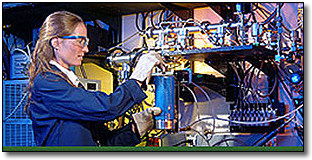
Image: NREL
 |
Image: NREL |
"We can potentially capture 50 percent of the energy stored in sugar
[in corn], whereas converting the sugar to ethanol and burning the ethanol in a
car would harvest only 20 percent of the energy in sugar."
- Lanny Schmidt, Regents Professor of Chemical Engineering
Minneapolis, St Paul - February 16, 2004 [SolarAccess.com]
The first reactor capable of producing hydrogen from a renewable fuel source -
ethanol - efficiently enough to hold economic potential has been invented by
University of Minnesota engineers. When coupled with a hydrogen fuel cell, the
unit - small enough to hold in your hand - could generate one kW of power,
almost enough to supply an average home, the researchers said.
The technology is poised to remove the major stumbling block to the
"hydrogen economy": no free hydrogen exists, except what is made at
high cost from fossil fuels. The work will be published in the Feb. 13 issue of
Science.
The researchers see an early use for their invention in remote areas, where the
installation of new power lines is not feasible. People could buy ethanol and
use it to power small hydrogen fuel cells in their basements. The process could
also be extended to biodiesel fuels, the researchers said. Its benefits include
reducing dependence on imported fuels, reducing carbon dioxide emissions
(because the carbon dioxide produced by the reaction is stored in the next
year's corn crop) and boosting rural economies.
Hydrogen is now produced exclusively by a process called steam reforming, which
requires very high temperatures and large furnaces-in other words, a huge input
of energy. It's unsuitable for any application except large-scale refineries,
said Lanny Schmidt, Regents Professor of Chemical Engineering, who led the
effort. Working with him were scientist Gregg Deluga, first author of the
Science paper, and graduate student James Salge. All three are in the
university's department of chemical engineering and materials science.
"The hydrogen economy means cars and electricity powered by hydrogen,"
said Schmidt. "But hydrogen is hard to come by. You can't pipe it long
distances. There are a few hydrogen fueling stations, but they strip hydrogen
from methane-natural gas-on site. It's expensive, and because it uses fossil
fuels, it increases carbon dioxide emissions, so this is only a short-term
solution until renewable hydrogen is available."
Ethanol is easy to transport and relatively nontoxic. It is already being
produced from corn and used in car engines. But if it were used instead to
produce hydrogen for a fuel cell, the whole process would be nearly three times
as efficient. That is, a bushel of corn would yield three times as much power if
its energy were channeled into hydrogen fuel cells rather than burned along with
gasoline, according to the researchers.
"We can potentially capture 50 percent of the energy stored in sugar [in
corn], whereas converting the sugar to ethanol and burning the ethanol in a car
would harvest only 20 percent of the energy in sugar," said Schmidt.
"Ethanol in car engines is burned with 20 percent efficiency, but if you
used ethanol to make hydrogen for a fuel cell, you would get 60 percent
efficiency."
The difference, Deluga explained, is due in large part to the need to remove all
the water from ethanol before it can be put in an automobile gas tank-and the
last drops of water are the hardest to remove. But the new process doesn't
require pure ethanol; in fact, it strips hydrogen from both ethanol and water,
yielding a hydrogen bonus.
The invention rests on two innovations: a catalyst based on the metals rhodium
and ceria, and an automotive fuel injector that vaporizes and mixes the
ethanol-water fuel. The vaporized fuel mixture is injected into a tube that
contains a porous plug made from rhodium and ceria. The fuel mixture passes
through the plug and emerges as a mixture of hydrogen, carbon dioxide and minor
products. The reaction takes only 50 milliseconds and eliminates the flames and
soot that commonly accompany ethanol combustion.
In a typical ethanol-water fuel mixture, one could ideally get five molecules of
hydrogen for each molecule of ethanol. Reacting ethanol alone would yield three
hydrogen molecules. So far, the Schmidt team has harvested four hydrogen
molecules per ethanol molecule.
"We're confident we can improve this technology to increase the yield of
hydrogen and use it to power a workable fuel cell," said Salge.
The work was supported by the University of Minnesota's Initiative on Renewable
Energy and the Environment, the National Science Foundation and the U.S.
Department of Energy.